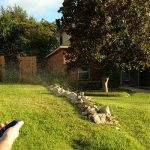More than 98 percent of the insects in your landscape are either beneficial or benign. For the remaining 2 percent, there are ways to manage these pests without harming the rest.
Anytime there is a beautiful landscape on display, there are insects lurking in the background to take advantage of opportunities for food and shelter among the plants.
For some, insects are unwelcome visitors to the landscape and must be removed. But for others, insects are welcome inhabitants — a reflection of the natural order and balance in the environment.
More than 98 percent of the insect species you see are either beneficial or benign in the environment and are just living their normal lives during your interactions with them. For the remaining 2 percent of insects that are pests or cause harm in some manner, there are many ways of managing them to a level that is acceptable and won’t cause problems.
A widely-accepted method of dealing with insect pests is called integrated pest management or IPM. Integrated pest management is a way to control pests by using a variety of approaches that don’t focus solely on pesticides. They include:
- Biological control – using beneficial insects or organisms to control pests and develop a natural pest/predator balance. (An example would be releasing ladybugs in a garden.)
- Mechanical control – physically removing the pest organism by hand or with traps and barriers.
- Cultural practices – selecting plants that are insect or disease resistant and/or drought tolerant.
- Monitoring – checking your landscape periodically for the presence of unwelcome plants or insects instead of regular treatments, and watering only when the landscape needs it.
- Acceptable pest levels – IPM focuses on management/control and not eradication. When the landscape is managed properly, insect predators and pests live in a balance. It helps to understand your landscape and how many insects can be present before damage occurs to the plants.
- Responsible pesticide use – sometimes using a pesticide is necessary to reduce pest populations that are out of control and are in danger of severely harming or killing plants. Follow labeled directions and use only the recommended amount. When it comes to insecticides, more is not better.
Combining a well-managed xeric landscape with IPM practices results in a beautiful array of native and drought-tolerant plants that provide color throughout the year, while maintaining a level of insect and disease resistance to satisfy even the most persnickety gardener.




